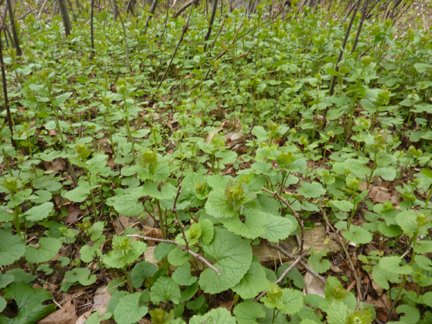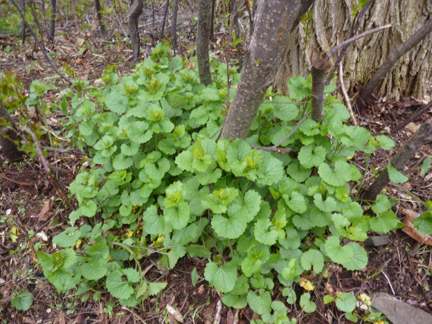The down side of not taking a weekend away is that all those projects and chores which are conveniently out of sight when we go road tripping stare at us and say “now.” The list for this weekend included framing the new raised beds, raking the leaves under the lilacs, rebuilding the grape arbor, and hopefully tending the two sections of hay-scented fern sod I put in last spring.
This fern sod was ordered and planted before I was prepared to give the sod the moisture it needed to get established. I was sharing a delivery with a friend who wanted them right away, but my outdoor faucet had frozen and split and needed to be soldered. I need to learn to solder. Instead, I spent over a week filling the watering can in the kitchen sink, and sprinkling the two long stretches of sod, one in the front of the house, and one in the back. It required multiple trips, while the newly purchased soaker hoses lay flat and empty. Finally, the faucet was fixed.
A few ferns appeared, but my friend had a tall dense strip of fern along the walkway to her house. My ferns were sparse, and barely survived. I hoped that after a winter of rest they would come forth the following spring healthy and forgetful of my poor nurturing.
This weekend I went to look for signs of life, and there they were—soft green tendrils and delicate miniature fronds. But a towering forest of garlic mustard had invaded their space and appeared ready to overwhelm and obliterate them. The item on my list called tending the ferns turned into eradicating the mustard.
We are so cognizant of rare species and protecting animal and plant populations that the idea of deliberately wiping something out seems wrong. It did feel wrong, but it also felt intensely satisfying. Trowel in hand I created piles of limp garlic mustard. Hours, about four without a rest, left the ferns exposed and a large area cleared around them. After a few backstretches, I let my focus widen. I wish I hadn’t. The lovely but nasty shoots were along the path to the well, and formed a border around the compost pile. I sighed, and using a favorite phrase of my dad’s, girded my loins and tackled them.
The day was devoured by garlic mustard. Black flies were ignored in my weeding frenzy. I was oblivious to everything except plant-by-plant removing the mustard. My watchstrap unsnapped and I unconsciously snapped it back. I felt a sharp sting and acknowledged a red ant bite. The pain did not subside, and I figured he was in the cuff of my garden glove stinging away. I could not be bothered to flick him out. I had mustard to remove. Finally the pain worked its way through my mustard killing mind, and I pulled back the glove to look. I had snapped a piece of my flesh in the watch band, and a white pustule and blood blister were the source of my discomfort, not a red ant. Watch stuffed in pocket, I went on. The towering piles of mustard were shoveled onto a trailer and hauled to our burn pile, as I would not give them the chance to grow in the compost. I then when back for more.
Dinner had been planned; chicken thighs with five-spice powder, jasmine rice, warm arugula salad with cashews and caramelized onions. Around eight thirty pm, when I was beginning to squint to see the mustard shoots, I got dragged away and taken out to dinner. I went to sleep feeling pretty satisfied. I knew I had missed many smaller ones, but would tackle them as they grew.
Garlic mustard, Alliaria petiolata
The next morning, Mother’s Day, we visited my mother-in-law and planned our day–a bike ride of course, and perhaps brunch at the Bar Harbor Inn.
I wanted to try moving some cranesbill geranium from the woodland garden to the area I had cleared of mustard. Cranesbills are one of my favorite plants. It has a sweet scent, is a lovely swath of pink in the spring, covers the ground and does not need weeding, and spreads, but gently. If it spreads too far, it is easy to pull it up, as its root system is shallow. It is a very civilized plant, unlike that mustard. I grabbed my trug, and feeling happy with a hard day’s work behind me went to the other side of the yard to move those cranesbills before biking or brunch.
I rounded the corner humming, approached the garden, and came to a halt. There they were. Not so many, but there they were. Growing in clusters by the Solomon’s Seal, and under the Piers Andromeda, garlic mustard, Alliaria petiolata, was stretching towards the sun. I asked my husband to go play golf or something, and rolled up my sleeves.
I will not admit they have won, but know that I have not. I will continue to pick them off, but accept they may be part of my life. A friend first identified this plant for me two years ago, shortly after it appeared in our yard. She was the one who warned me how invasive it was. She also mentioned that it is edible. There are recipes for pesto, soup and salad with garlic mustard. Stir-fried garlic mustard with roasted sesame seeds and ginger could be a sweet revenge.
Alliaria petiolata is not going to go away. There is far too much to eliminate. I see it smiling at me from behind the summer bedroom and boldly nodding along the edges of the wood shed. Garlic mustard is an enticing name, however, and the leaves are pungent and tasty.
Perhaps a roadside sign:
U Pick, Garlic mustard, $2.00 per pint. We pay you.


